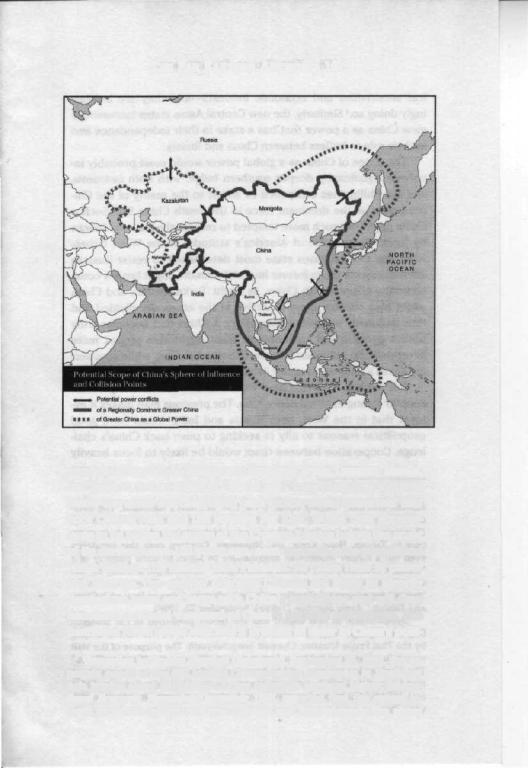
Grand_Chessboard
.pdf
THE FAR EASTERN ANCHOR 163
demanding. That combination of felicitous circumstances may prove difficult to attain. Experience teaches that pressures for democratization from below, either from those who have felt themselves politically suppressed (intellectuals and students) or economically exploited (the new urban labor class and the rural poor), generally tend to outpace the willingness of rulers to yield. At some point, the politically and the socially disaffected in China are likely to join forces in demanding more democracy, freedom of expression, and respect for human rights. That did not happen in Tiananmen Square in 1989, but it might well happen the next time.
Accordingly, it is unlikely that China will be able to avoid a phase of political unrest. Given its size, the reality of growing regional differences, and the legacy of some fifty years of doctrinal dictatorship, such a phase could be disruptive both politically and economically. Even the Chinese leaders themselves seem to expect as much, with internal Communist Party studies undertaken in the early 1990s foreseeing potentially serious political unrest.1 Some China experts have even prophesied that China might spin into one of its historic cycles of internal fragmentation, thereby halting China's march to greatness altogether. But the probability of such an extreme eventuality is diminished by the twin impacts of mass nationalism and modern communications, both of which work in favor of a unified Chinese state.
There is, finally, a third reason for skepticism regarding the prospects of China's emergence in the course of the next twenty or so years as a truly major—and to some Americans, already menac- ing—global power. Even if China avoids serious political disruptions and even if it somehow manages to sustain its extraordinarily high rates of economic growth over a quarter of a century—which are both rather big "ifs"—China would still be relatively very poor. Even a tripling of GDP would leave China's population in the lower ranks of the world's nations in per capita income, not to mention
'"Official Document Anticipates Disorder During the Post-Deng Period,™ ChengMing(HongKong),February1, 1995,providesadetailedsummaryof two analyses prepared lor the Party leadership concerning various forms of potential unrest. A Western perspective on the same topic is contained in Richard Baum, "ChinaAlter Deng; Ten Scenarios in Search of Reality," China Quarterly(March1996).

164 THE GRAND CHESSBOARD
the actual poverty of a significant portion of its people.2 Its comparative standing in per capita access to telephones, cars, and computers, let alone consumer goods, would be very low.
To sum up: even by the year 2020, it is quite unlikely even under the best of circumstances that China could become truly competitive in the key dimensions of global power. Even so, however, China is well on the way to becoming the preponderant regional power in East Asia. It is already geopoiitically dominant on the mainland. Its military and economic power dwarfs its immediate neighbors, with the exception of India. It is, therefore, only natural that China will increasingly assert itself regionally, in keeping with the dictates of its history, geography, and economics.
Chinese students of their country's history know that as recently as 1840, China's imperial sway extended throughout Southeast Asia, all the way down to the Strait of Malacca, including Burma, parts of today's Bangladesh as well as Nepal, portions of today's Kazakstan, all of Mongolia, and the region that today is called the Russian Far Eastern Province, north of where the Amur River flows into the ocean (see map on page 14 in chapter 1). These areas were either under some form of Chinese control or paid tribute to China. Franco-British colonial expansion ejected Chinese influence from Southeast Asia during the years 1885-95, while two treaties imposed by Russia in 1858 and 1864 resulted in territorial losses in the Northeast and Northwest. In 1895, following the Sino-Japanese War, China also lost Taiwan.
It is almost certain that history and geography will make the Chinese increasingly insistent—even emotionally charged—re- garding the necessity of the eventual reunification of Taiwan with the mainland. It is also reasonable to assume that China, as its power grows, will make that goal its principal objective during the first decade of the next century, following the economic absorption and political digestion of Hong Kong. Perhaps a peaceful re- unification—maybe under a formula of "one nation, several
2In the somewhat optimistic report titled "China's Economy Toward the 21st Century" (Zou xiang 21 shiji de Zhongguo jinji), issued in 1996 by the Chinese Institute for Quantitative Economic and Technological Studies, it was estimated that the per capita income in China in 2010 will be approximately S735, or less than $30 higher than the World Bank definition of a lowincome country.

THE FAR EASTERN ANCHOR 165
systems" (a variant of Deng Xiaoping's 1984 slogan "one country, two systems")—might become appealing to Taiwan and would not be resisted by America, but only if China has been successful in sustaining its economic progress and adopting significant democratizing reforms. Otherwise, even a regionally dominant China is still likely to lack the military means to impose its will, especially in the face of American opposition, in which case the issue is bound to continue galvanizing Chinese nationalism while souring American-Chinese relations.
Geography is also an important factor driving the Chinese interest in making an alliance with Pakistan and establishing a military presence in Burma. In both cases, India is the geostrategic target. Close military cooperation with Pakistan increases India's security dilemmas and limits India's ability to establish itself as the regional hegemon in South Asia and as a geopolitical rival to China. Military cooperation with Burma gains China access to naval facilities on several Burmese offshore islands in the Indian Ocean, thereby also providing some further strategic leverage in Southeast Asia generally and in the Strait of Malacca particularly. And if China were to control the Strait of Malacca and the geostrategic choke point at Singapore, it would control Japan's access to Middle Eastern oil and European markets.
Geography, reinforced by history, also dictates China's interest in Korea. At one time a tributary state, a reunited Korea as an extension of American (and indirectly also of Japanese) influence would be intolerable to China. At the very minimum, China would insist that a reunited Korea be a nonaligned buffer between China and Japan and would also expect that the historically rooted Korean animosity toward Japan would of itself draw Korea into the Chinese sphere of influence. For the time being, however, a divided Korea suits China best, and thus China is likely to favor the continued existence of the North Korean regime.
Economic considerations are also bound to influence the thrust of China's regional ambitions. In that regard, the rapidly growing demand for new energy sources has already made China insistent on a dominant role in any regional exploitation of the seabed deposits of the South China Sea. For the same reason, China is beginning to display an increasing interest in the independence of the energy-rich Central Asian states. In April 1996, China,

166 THE GRAND CHESSBOARD
Russia, Kazakstan, Kyrgyzstan, and Tajikistan signed a joint border and security agreement; and during President Jiang Zemin's visit to Kazakstan in July of the same year, the Chinese side was quoted as having provided assurances of China's support for "the efforts made by Kazakstan to defend its independence, sovereignty, and territorial integrity." The foregoing clearly signaled China's growing involvement in the geopolitics of Central Asia.
History and economics also conspire to increase the interest of a regionally more powerful China in Russia's Far East. For the first time since China and Russia have come to share a formal border, China is the economically more dynamic and politically stronger party. Seepage into the Russian area by Chinese immigrants and traders has already assumed significant proportions, and China is becoming more active in promoting Northeast Asian economic cooperation that also engages Japan and Korea. In that cooperation, Russia now holds a much weaker card, while the Russian Far East increasingly becomes economically dependent on closer links with China's Manchuria, Similar economic forces are also at work in China's relations with Mongolia, which is no longer a Russian satellite and whose formal independence China has reluctantly recognized.
A Chinese sphere of regional influence is thus in the making. A sphere of influence, however, should not be confused with a zone of exclusive political domination, such as the Soviet Union exercised in Eastern Europe. It is socioeconomically more porous and politically less monopolistic. Nonetheless, it entails a geographic space in which its various states, when formulating their own policies, pay special deference to the interests, views, and anticipated reactions of the regionally predominant power. In brief, a Chinese sphere of influence—perhaps a sphere of deference would be a more accurate formulation—can be defined as one in which the very first question asked in the various capitals regarding any given issue is "What is Beijing's view on this?"
The map that follows traces out the potential range over the next quarter of a century of a regionally dominant China and also of China as a global power, in the event that—despite the internal and external obstacles already noted—China should actually become one. A regionally dominant Greater China, which would mobilize the political support of its enormously rich and economically

THE FAR EASTERN ANCHOR 167
powerful diaspora in Singapore, Bangkok, Kuala Lumpur, Manila, and Jakarta, not to speak of Taiwan and Hong Kong (see footnote below for some startling data)3 and which would penetrate into both Central Asia and the Russian Far East, would thus approximate in its radius the scope of the Chinese Empire before the onset of its decline some 150 years ago, even expanding its geopolitical range through the alliance with Pakistan. As China rises in power and prestige, the wealthy overseas Chinese are likely to identify themselves more and more with China's aspirations and will thus become a powerful vanguard of China's imperial momentum. The Southeast Asian states may find it prudent to defer to China's polit-
'According to Yazhou Zhoukan (Asiaweek), September 25, 1994, the aggregate assets of the 500 leading Chinese-owned companies in Southeast Asia totaled about $540 billion. Other estimates are even higher: International Economy, November/December 1996, reported that the annual income of the 50 million overseas Chinese was approximately the above

168 THE GRAND CHESSBOARD
ical sensitivities and economic interests—and they are increasingly doing so/ Similarly, the new Central Asian states increasingly view China as a power that has a stake in their independence and in their role as buffers between China and Russia.
The scope of China as a global power would most probably involve a significantly deeper southern bulge, with both Indonesia and the Philippines compelled to adjust to the reality of the Chinese navy as the dominant force in the South China Sea. Such a China might be much more tempted to resolve the issue of Taiwan by force, irrespective of America's attitude. In the West, Uzbekistan, the Central Asian state most determined to resist Russian encroachments on its former imperial domain, might favor a countervailing alliance with China, as might Turkmenistan; and China might also become more assertive in the ethnically divided and thus nationally vulnerable Kazakstan. A China that becomes truly both a political and an economic giant might also project more overt political influence into the Russian Far East, while sponsoring Korea's unification under its aegis (see map on page 167).
But such a bloated China would also be more likely to encounter strong external opposition. The previous map makes it evident that in the West, both Russia and India would have good geopolitical reasons to ally in seeking to push back China's challenge. Cooperation between them would be likely to focus heavily
amount and thus roughly equal to the GDP of China's mainland. The overseas Chinese were said to control about 90 percent of Indonesia's economy, 75 percent of Thailand's, 50-60 percent of Malaysia's, and the whole economy in Taiwan, Hong Kong, and Singapore. Concern over this condition even led a former Indonesian ambassador to Japan to warn publicly of a "Chinese economic intervention in the region," which might not only exploit such Chinese presence but which could even lead to Chinese-sponsored "puppet governments" (Saydiman Suryohadiprojo, "How to Deal with China and Taiwan," Asahi Shimbun [Tokyo], September 23,1996).
^Symptomatic in that regard was the report published in the Bangkok English-language daily, The Nation (March 31, 1997), on the visit to Beijing by the Thai Prime Minister, Chavalit Yongchaiyudh. The purpose of the visit was defined as establishing a firm strategic alliance with "Greater China." The Thai leadership was said to have "recognized China as a superpower that has a global role," and as wishing to serve as "a bridge between China and ASEAN." Singapore has gone even farther in stressing its identification with China.

THE FAR EASTERN ANCHOR 169
on Central Asia and Pakistan, whence China would threaten their interests the most. In the south, opposition would be strongest from Vietnam and Indonesia (probably backed by Australia). In the east, America, probably backed by Japan, would react adversely to any Chinese efforts to gain predominance in Korea and to incorporate Taiwan by force, actions that would reduce the American political presence in the Far East to a potentially unstable and solitary perch in Japan.
Ultimately, the probability of either scenario sketched out on the maps fully coming to pass depends not only on how China itself develops but also very much on American conduct and presence. A disengaged America would make the second scenario much more likely, but even the comprehensive emergence of the first would require some American accommodation and self-re- straint. The Chinese know this, and hence Chinese policy has to be focused primarily on influencing both American conduct and, especially, the critical American-Japanese connection, with China's other relationships manipulated tactically with that strategic concern in mind.
China's principal objection to America relates less to what America actually does than to what America currently is and where it is. America is seen by China as the world's current hegemon, whose very presence in the region, based on its dominant position in Japan, works to contain China's influence. In the words of a Chinese analyst employed in the research arm of the Chinese Foreign Ministry: "The U.S. strategic aim is to seek hegemony in the whole world and it cannot tolerate the appearance of any big power on the European and Asian continents that will constitute a threat to its leading position."5 Hence, simply by being what it is and where it is, America becomes China's unintentional adversary rather than its natural ally.
Accordingly, the task of Chinese policy—in keeping with Sun Tsu's ancient strategic wisdom—is to use American power to
'Song Yimin. "A Discussion of the Division and Grouping oi Forces in the WorldAftertheEndoftheCoidWar,"Internationa!Studies(ChinaInstituteof Internationa] Studies, Beijing) 6-8 (1996):10. That this assessment of America represents the view of China's top leadership is indicated by the fact that a shorter version oi the analysis appeared in the mass-circulation official organ oftheParty,RenminRibao(People'sDaily), April 29, 1996.

170 THE GRAND CHESSBOARD
peacefully defeat American hegemony, but without unleashing any latent Japanese regional aspirations. To that end, China's geostrategy must pursue two goals simultaneously, as somewhat obliquely defined in August 1994 by Deng Xiaoping: "First, to oppose hegemonism and power politics and safeguard world peace; second, to build up a new international political and economic order." The first obviously targets the United States and has as its purpose the reduction in American preponderance, while carefully avoiding a military collision that would end China's drive for economic power; the second seeks to revise the distribution of global power, capitalizing on the resentment in some key states against the current global pecking order, in which the United States is perched at the top, supported by Europe (or Germany) in the extreme west of Eurasia and by Japan in the extreme east.
China's second objective prompts Beijing to pursue a regional geostrategy that seeks to avoid any serious conflicts with its immediate neighbors, even while continuing its quest for regional preponderance. A tactical improvement in Sino-Russian relations is particularly timely, especially since Russia is now weaker than China. Accordingly, in April 1997, both countries joined in denouncing "hegemonism" and declaring NATO's expansion "impermissible." However, it is unlikely that China would seriously consider any long-term and comprehensive Russo-Chinese alliance against America. That would work to deepen and widen the scope of the American-Japanese alliance, which China would like to dilute slowly, and it would also isolate China from critically important sources of modern technology and capital.
As in Sino-Russian relations, it suits China to avoid any direct collision with India, even while continuing to sustain its close military cooperation with Pakistan and Burma. A policy of overt antagonism would have the negative effect of complicating China's tactically expedient accommodation with Russia, while also pushing India toward a more cooperative relationship with America. To the extent that India also shares an underlying and somewhat antiWestern predisposition against the existing global "hegemony," a reduction in Sino-Indian tensions is also in keeping with China's broader geostrategic focus.
The same considerations generally apply to China's ongoing relations with Southeast Asia. Even while unilaterally asserting their

THE FAR EASTERN ANCHOR 171
claims to the South China Sea, the Chinese have simultaneously cultivated Southeast Asian leaders (with the exception of the historically hostile Vietnamese), exploiting the more outspoken antiWestern sentiments (particularly on the issue of Western values and human rights) that in recent years have been voiced by the leaders of Malaysia and Singapore. They have especially welcomed the occasionally strident anti-American rhetoric of Prime Minister Datuk Mahathir of Malaysia, who in a May 1996 forum in Tokyo even publicly questioned the need for the U.S.-Japan Security Treaty, demanding to know the identity of the enemy the alliance is supposed to defend against and asserting that Malaysia does not need allies. The Chinese clearly calculate that their influence in the region will be automatically enhanced by any diminution of America's standing.
In a similar vein, patient pressure appears to be the motif of China's current policy toward Taiwan. While adopting an uncompromising position with regard to Taiwan's international status— to the point of even being willing to deliberately generate international tensions in order to convey China's seriousness on this matter (as in March 1996)—the Chinese leaders presumably realize that for the time being they will continue to lack the power to compel a satisfactory solution. They realize that a premature reliance on force would only serve to precipitate a self-defeating clash with America, while strengthening America's role as the regional guarantor of peace. Moreover, the Chinese themselves acknowledge that how effectively Hong Kong is first absorbed into China will greatly determine the prospects for the emergence of a Greater China.
The accommodation that has been taking place in China's relations with South Korea is also an integral part of the policy of consolidating its flanks in order to be able to concentrate more effectively on the central goal. Given Korean history and public emotions, a Sino-Korean accommodation of itself contributes to a reduction in Japan's potential regional role and prepares the ground for the reemergence of the more traditional relationship between China and (either a reunited or a still-divided) Korea.
Most important, the peaceful enhancement of China's regional standing will facilitate the pursuit of the central objective, which ancient China's strategist Sun Tsu might have formulated as fol-

172 THE GRAND CHESSBOARD
lows: to dilute American regional power to the point that a diminished America will come to need a regionally dominant China as its ally and eventually even a globally powerful China as its partner.
This goal is to be sought and accomplished in a manner that does not precipitate either a defensive expansion in the scope of the American-Japanese alliance or the regional replacement of America's power by that of Japan.
To attain the central objective, in the short run, China seeks to prevent the consolidation and expansion of American-Japanese security cooperation. China was particularly alarmed at the implied increase in early 1996 in the range of U.S.-Japanese security cooperation from the narrower "Far East" to a wider "Asia-Pacific," perceiving in it not only an immediate threat to China's interests but also the point of departure for an American-dominated Asian system of security aimed at containing China (in which Japan would be the vital linchpin,6 much as Germany was in NATO during the Cold War). The agreement was generally perceived in Beijing as facilitating Japan's eventual emergence as a major military power, perhaps even capable of relying on force to resolve outstanding economic or maritime disputes on its own. China thus is likely to fan energetically the still strong Asian fears of any significant Japanese military role in the region, in order to restrain America and intimidate Japan.
However, in the longer run, according to China's strategic calculus, American hegemony cannot last. Although some Chinese, especially among the military, tend to view America as China's im-
fiAn elaborate examination of America's alleged intent to construct such an anti-China Asian system is contained in Wang Chunyin, "Looking Ahead to Asia-Pacific Security in the Early Twenty-first Century," Guoji Zhanwang (World Outlook), February 1996.
Another Chinese commentator argued that the American-Japanese security arrangement has been altered from a "shield of defense" aimed at containing Soviet power to a "spear of attack" pointed at China (Yang Baijiang, "Implications of Japan-U.S. Security Declaration Outlined," Xiandai Guoji Guanxi [Contemporary International Relations], June 20, 1996). On January 31, 1997, the authoritative daily organ of the Chinese Communist Party, Renmin Ribao, published an article entitled "Strengthening Military Alliance Does Not Conform with Trend of the Times," In which the redefinition of the scope of the U.S.- Japanese military cooperation was denounced as "a dangerous move."
